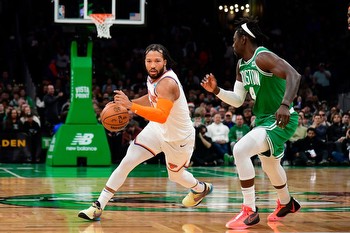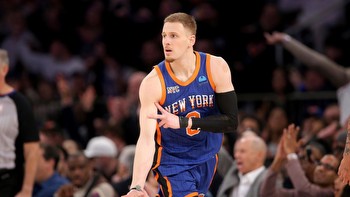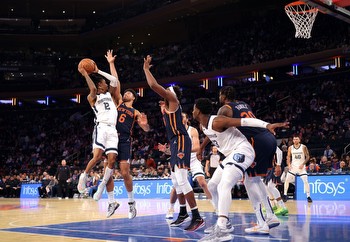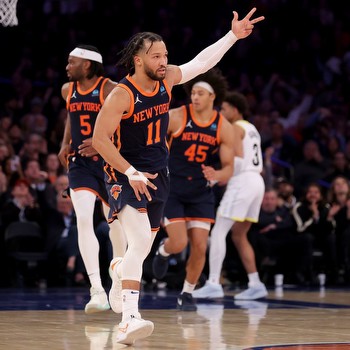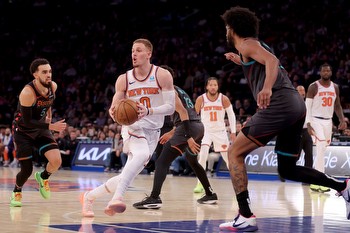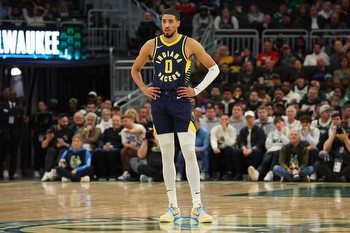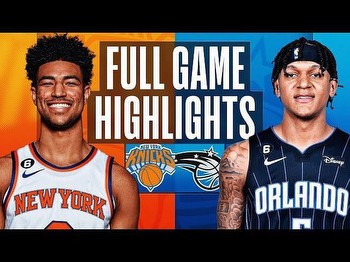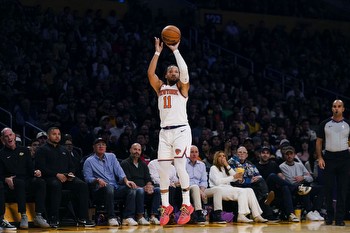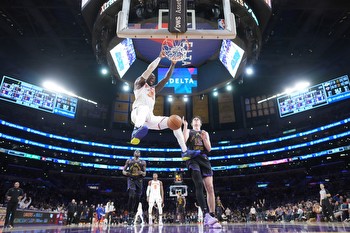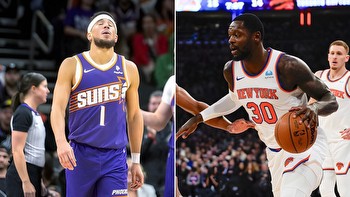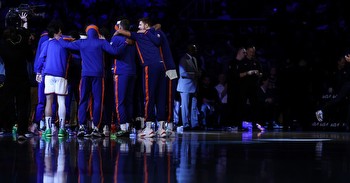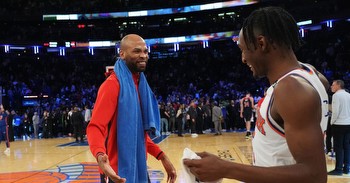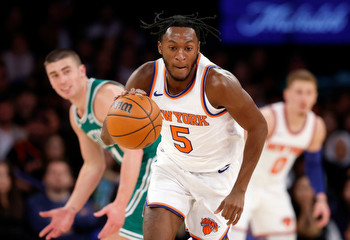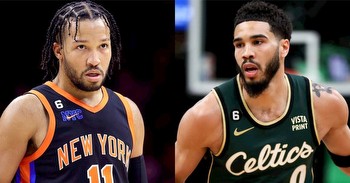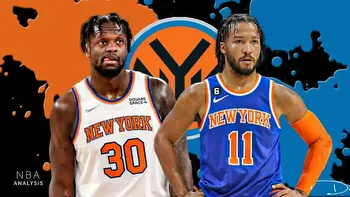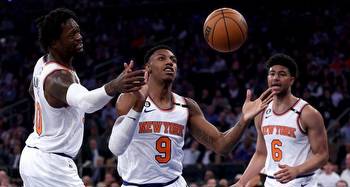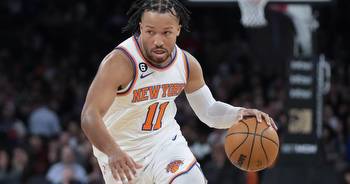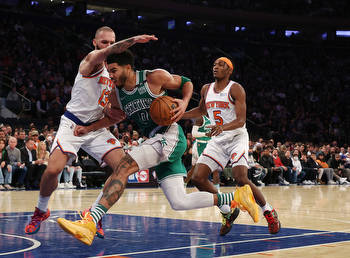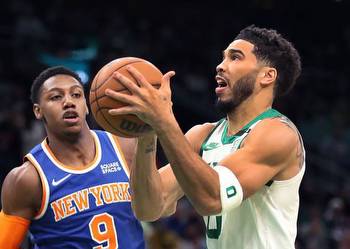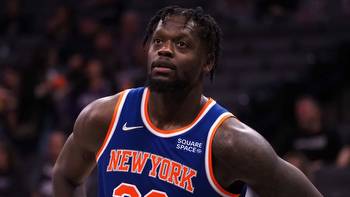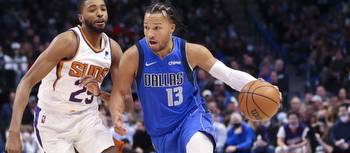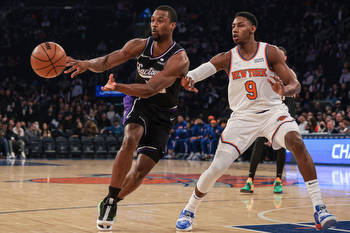Knicks’ Jericho Sims as a power forward, RJ Barrett’s free-throw climb and more

The New York Knicks’ centers have an exclusive club.
Throughout last season, they hung around each other constantly. They made sure their cubbies were all lined up in visiting locker rooms. Walk into the Knicks’ quarters of a road arena and you would see the trio: Mitchell Robinson, Isaiah Hartenstein and Jericho Sims sitting together and showing off their affable dynamic.
Robinson and Hartenstein would put on mini-comedy acts as the notoriously quiet Sims sat nearby, absorbing the moment without any expression. Getting into Sims’ mind, as Robinson and Hartenstein will tell you, is a challenge. But that didn’t stop them from trying.
Before a mid-March game in Portland last season, the Knicks’ two goofballs levied new legislation on behalf of the centers club. Sims, they said, was banished, no longer one of the big men. The high-flyer had participated in the dunk contest at All-Star weekend the month before, which is far too cool a task to renew his membership with a group that prided itself on low-post grit.
Robinson told Sims he wasn’t a big man anymore. “He’s a power forward now,” he said to Hartenstein, who agreed. Of course, Sims was the only one who kept a straight face.
Or so we thought. As it turns out, an important person may have been listening in on that conversation: Knicks head coach Tom Thibodeau.
During the Knicks’ preseason opener Monday night, Sims played most of his 26 minutes at power forward, which occurred because Josh Hart, the team’s anticipated backup four, didn’t play. And yet, we may see Sims next to one of his big-man buddies more often this season than we did in 2022-23.
“We wanted to get a look at that with (Sims) on the floor,” Thibodeau said. “With Josh out and Julius (Randle) playing limited minutes, it was a good opportunity for that.”
Sims played only 139 minutes alongside either Hartenstein or Robinson last season. Opponents outscored the Knicks by seven during that time. Now, Thibodeau believes this look could be an option if the Knicks are in a pinch, despite the scrunched spacing that occurs with two rim-diving centers (which is the case to the extreme when Sims and Robinson play together) alongside each other.
First, Thibodeau believes it can work defensively. Sims is quick-footed enough to guard the perimeter. He gives the team another paint defender next to its center, too.
The questions come about offense. There were various possessions in the preseason opener, a 114-107 win over the Boston Celtics, when a Knicks dribbler would aim for the paint but get nothing out of it because too many defenders were there waiting for him. When crowds form, things can get sloppy. Maybe the Knicks have to pull the ball back out and are rushed without much time on the shot clock, or they commit a frantic turnover or someone has to chuck up an uncomfortable shot out of a triple-team.
The Knicks placed Robinson around the rim and, more often than not, started Sims in the corner, where the Celtics didn’t guard him. Sims was active as a screener, hoping to open up teammates with his defender lingering far away from the play. That may not be enough to create easy buckets, given the personnel. But this is the Knicks, a team that dominated on offense a season ago in an unconventional way. And Thibodeau is betting that can happen again.
Part of the reason the Knicks offense was so effective last season was because of Robinson’s offensive boards. New York got more second chances than Billy Martin. Rebounding hit another level during the Hartenstein-Sims lineups, which Thibodeau used for a few minutes a night when Obi Toppin was injured in December. With those two sharing the floor, the Knicks recovered 40 percent of their misses, which blew away the work any other type of unit did.
Thibodeau has told people around him that he doesn’t believe the 40 percent number was a fluke, even if it came in only 128 minutes. So maybe this is a look we see during the regular season — not when the Knicks have all nine rotation players healthy but if someone is missing.
Sims at power forward is only one Knicks-related thought as the team prepares for exhibition No. 2. Here are four more:
All about timing
It took half a season for Hartenstein to get comfortable in New York. Could the trend continue into Year 2?
Take a look at this fourth-quarter pass to Evan Fournier:
There are two reactions to this play.
First, wowza. What a pass.
And second, why would anyone still be watching the fourth quarter of a preseason game that no starters are playing in anymore closely enough to notice a good pass, then go back and analyze a play from it? But this is a judgment-free zone, so let’s delve further into it.
The play is all about timing. Fournier curves around the screen from Miles McBride, and he has options. He can curl around Hartenstein for a dribble-handoff or (if his defender steps up, as we see here) he can back cut to the rim.
The pass is stunning, a zinger with the beauty, speed and accuracy of a Chad Pennington-to-Anthony Becht bootleg. But there’s the other side of this: The cut from Fournier, who noticed a lane to the hoop and took off with precision.
As Fournier knows, he probably won’t play much, if at all, this season. But he’s not the only one who can make this play. As the veteran guard sliced to the rim, I had a thought: The Knicks would be in good shape if Quentin Grimes, who runs around similar screens, could learn how to notice the position of his defender and make a cut like this more often.
Fournier falling off the map last season didn’t just cost the Knicks long-range shooting. They also lost movement in their offense.
During Year 1 with the Knicks, Fournier scampered around screens, cut constantly and flashed the automatic green light. He’s a crafty cutter. He knows how to read defenses, just as he did on the Hartenstein play. And it’s not like the Knicks, who finished last season tied for third in points per possession, yearned for the scoring. But as Thibodeau often says, offensive versatility is important. Fournier gave them that, but he’s not the only one who can do it.
Grimes is the first player who comes to mind for a reason. He can shoot, too, which makes his defender more likely to step up in anticipation of a dribble-handoff. For example, RJ Barrett runs similar actions to this, but defenders don’t worry about him grabbing the ball from Hartenstein and chucking an off-the-dribble 3, so they play farther back on him, which doesn’t leave this cut open. Opponents would take a similar strategy guarding Hart.
The 23-year-old Grimes is a quick decision-maker. Maybe the Knicks bust out some Fournier-esque off-ball movement for him this season. This cut could be open for Donte DiVincenzo, too. Maybe that’s the guy we see pull it off the most since Hartenstein, one of the NBA’s best-passing centers, must be in the game to make it happen, and DiVincenzo will run next to him in the reserve units. And if Hartenstein continues his growth from last season, when he struggled at the beginning while learning a new role and recovering from an Achilles injury and ended as one of the Knicks’ most consistent performers, then timing plays like this could be even more frequent.
Getting freebies
Barrett’s 9-of-9 showing at the free-throw line to begin the preseason is no accident, so says Barrett, himself.
He told me after Monday’s game that he is “definitely a better free-throw shooter.”
“I told you I was gonna work on it over the summer,” he said. “Just reps.”
It’s been a slow climb for Barrett, who has said he wants to get his free-throw percentage above 80 percent. He shot 74 percent last season, up three points from the previous one, and is at 71 percent for his career.
The Knicks could use improved accuracy, especially considering how often he gets to the line. New York is filled with foul-drawers: Barrett, Randle and Jalen Brunson, especially. It took the third-most free throws in the league last season but was only 22nd in percentage.
One way to up that number: Get Barrett above 80 percent from the stripe.
“I’ve just had this same form for a couple of years now,” Barrett said. “I’ve just been working on it, so it’s more natural.”
Sitting out
The Celtics, on the second half of a back-to-back, sat all their most important players during the Knicks’ preseason opener Monday. Meanwhile, the Knicks have consecutive games next week, when they go up to Boston on Oct. 17 and come back to Madison Square Garden for a match against the Washington Wizards the following evening.
The scheduling seems counterproductive. And at least one Knicks player agrees.
“I don’t wanna be playing,” Randle said when asked if he’d compete in both sects of the upcoming back-to-back games.
So it sounds like Randle will sit — and for good reason. Why strain the body so much for a game that doesn’t matter, especially while coming back from offseason ankle surgery? And if Randle doesn’t go, there’s a good chance the Knicks’ other high-usage players could sit, too.
It lends a question: Why the heck are there back-to-backs in the preseason, which spreads four games out over two weeks?
The reasoning, as you may anticipate, has nothing to do with basketball. And the scheduling gods turned this particular back-to-back into a three-headed monster.
The Knicks aren’t the only ones who use the Garden. The Rangers play two home games next week. There are concerts on the docket, as well. Boston also has hockey, basketball and concerts. So does Washington. It makes planning games for those three teams (organizations agree to multiyear deals to play each other in the preseason) a logistical mess.
And that’s how you get the Celtics’ top guys sitting for one of the games against the Knicks and possibly the Knicks’ sitting for the other.
Trendsetter
We’ve all been discussing the wrong Fournier storyline. Throughout the summer, Fournier voiced his discontent about still being on the Knicks, who won’t play him much, if at all. And amidst all the basketball talk, we missed the most important change to Fournier’s game.
Forget about recovering the 18-point scorer who was in there not too long ago. This is about fashion.
For the first time in years, Fournier is wearing a T-shirt under his jersey, a trend he pulled off with the Orlando Magic and later with the Boston Celtics but dropped once he arrived in New York.
“With the Magic, the way the jersey was, it kinda transitioned very well with the shirt, but here we have those bands (on the periphery of the jersey). … I just thought looked weird,” Fournier said. “But this year I’m like, screw it. Back to that.”

